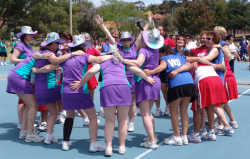Dorothy – 11/07/03
Sister Pauline O’Regan has become well-known in Christchurch and beyond for her work in education and more recently for the books she has published. In A Changing Order (1986) she throws light on the changes that have taken place in the Catholic Church by describing her own life and faith journey. She entered the order of the Sisters of Mercy in 1942 when she was twenty one. After teaching for some thirty years she resigned from her position as Principal at Villa Maria College for Girls in 1973 and with other sisters, Sister Teresa O’Connor and Sister Helen Goggin, she moved out of the convent and into a state house in the Christchurch suburb of Aranui.
The Sisters’ goals In Part One Chapter 1 of A Changing Order Sister Pauline writes:
“We had only one goal: to try to be good neighbours and to do everything we could to build up neighbourliness all around us. It was simple and realisable, and in the intervening years we have had no reason to modify it. At the same time, we could never have perceived on that February day what unexpected paths that simple goal would lead us to.”
They decided to support themselves so that they could make independent decisions. Sister Pauline was to be the breadwinner at first and took a teaching position at Aranui High School – such a different experience as a lay teacher no longer wearing the clothes that set her apart as a Sister.
The Sisters who did not go to work learnt the value of hanging out washing as a setting for conversation with people walking past on the streets, so did a load of washing every day, and after three or four weeks people began dropping in for a cup of tea.
Pauline O’Regan gives a vivid and sympathetic account of the people whom they encountered and of their problems. For their new friends getting to know the Sisters was a new experience, and the Sisters declare that their learning about others’ lives and the educational gain were invaluable for them. They had lived with women in their families and in the convent and they had all taught young women in secondary school, but now they related to women without having any set role or any common interest, and felt a huge sense of admiration for the strength and courage their new friends showed under extremely difficult conditions.
She writes with warm affection about the women who became the Sisters’ friends, sharing thoughts and feelings over cups of tea – times which opened up opportunities for the Sisters to offer help with problems and above all provide companionship for the lonely. In particular they were able to provide friendship, support and a listening ear for women known as ‘the solos’ – mothers who after a broken marriage were struggling to bring up children alone, so often tortured by a sense of self-blame for being in that situation and almost always lonely.
She comments about the changes in New Zealand society from one which took a pride in its socialism to one which showed resentment towards those who were forced by their circumstances to accept financial help from the government. A special vocabulary has grown up with phrases like ‘bludger on the welfare state’, ‘living off the taxpayer’. Generalised condemnatory comments about solo mothers deeply distressed the Sisters who now witnessed close at hand these mothers’ courageous struggles to do their best for their families. When she published an article in their defence Sister Pauline received letters condemning the Sisters’ move into the community. However the Sisters continued to protest when the Domestic Purposes Benefit was reduced, and when they came to understand the fears that prevented the women themselves from protesting the Sisters felt a responsibility to act on their behalf.
Move to a street with a reputation for gang activity and violent episodes A new stage in their community came when the Sisters moved to a street well-known for youthful gangs and violent episodes. Here they once again found warm and interesting people. Many lacked education and had no confidence in dealing with the court system or the Social Welfare Department, so the Sisters gave them company and support in these situations which were new and daunting to the Sisters as well because they had led such sheltered lives. As the number of unemployed rose and the number of jobs shrank the Sisters encouraged community efforts to combat unemployment. As they increasingly identified with the workers, paid or unpaid, who lived around them they began to question many deeply held convictions about the capitalist system.
I have read A Changing Order (1986) more than once and found my interest totally held by the content and the way it was presented – with enriching examples and enlivening touches of humour. As I read it I kept wanting to share passages and read them aloud to anyone who was at home.
There Is Hope for a Tree (1995) This book begins with the visit of Pope John Paul II to Ireland in 1979. and goes on to discuss controversial issues affecting the Catholic Church today – Papal infallibility, liturgical changes introduced by the Second Vatican Council and their divisive impact, the encyclical on contraception, the way women in the Church battle centuries of repression. Whether you belong to the Catholic church or any other church, or are only interested in the place of the Christian church in the contemporary world this book with its clear and courageous comments will provide much food for thought. Again I found it a book that needed to be shared with others and discussed.
Aunts and Windmills (1991) As the intriguing title suggests in this book Pauline O’Regan describes her early years in a small West Coast community, commenting not only on the view from the windmill, but also on social patterns and rituals, religious observances and the Murchison earthquake. Her skill as a writer brings alive life in the thirties in a small country settlement in New Zealand, with the warm attitude to people and the humorous comments we have come to expect in her work.
Books about working in the community With Teresa O’Connor Pauline O’Regan has also co-authored two books based on their experiences working in the community. In COMMUNITY Give It A Go! (1989) they describe their work in building community, – how they established networks, started coffee groups, and arranged childcare – and what they learnt about the relationships between local community workers and professional groups.
I CAN CHANGE ANYTHING (but not on my own) (1992) was written by the same two Sisters and is a quick reference source to be used in combination with COMMUNITY Give It A Go! which offers experience-based advice on forming groups working in a team, developing leadership skills, and anything which breaks down loneliness and isolation in a local area and helps to develop a community spirit.
PARISH for the people in the pews is co-authored by Father Kevin Burns and Sister Pauline O’Regan to provide an accessible foundation for lay ministry in the church – a theologically sound book for individual reading or as a basis for group discussion.
I strongly recommend you to read some of the above books and in the process learn about the lives and needs of people living in New Zealand cities at this time. The way they are written makes the learning process both absorbing and entertaining.


